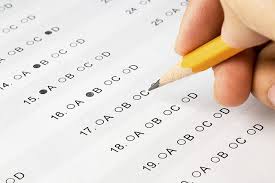Q: What is the best way to study for a multiple-choice test?
- A. Review the material for the first time as you drive to school
- B. Follow this informative set of guidelines
- C. “Work together” with the smart kid who sits in front of you

- Begin studying early- there is a lot to cover and cannot be done the night before the test. You’ll end up confusing yourself even more if you try to memorize concepts and formulas in a rush. By giving yourself plenty of time to read, practice and absorb each section of the chapter, you will have a better understanding of the subject and know more of the correct answers.
- Brainstorm (alone, with your tutor or with other classmates) examples of questions that might appear on the test. Quiz each other with multiple choice answers so you get some practice finding the correct answer
- When it’s time to take the test, read the question and use your hand or a piece of paper to cover the multiple-choice options. This way, you can think about the problem and not have all of the extra words/numbers to distract you. Solve the problem and then look to see if your answer is there. If it is, select it but make sure to double check that there isn’t a better answer.
- Look for words like “always” and “never.” These answers are correct less often than answers with words like “usually” or “probably”
- All Of The Above is usually a right answer. First, of course, make sure you can pinpoint at least two answers that correctly answer the question.
- Put your English skills to the test. If the questions ends is “an” then the answer will be start with a vowel. This may help eliminate a few wrong answers.
- Look for repetition. If many of the keywords in the answer are repeated from the question, that answer is likely to be correct.
- Subconsciously, teachers often put the correct answer “hidden” amongst the choices, so if you’re absolutely stumped and making a guess, try “B” or “C” instead of “A”
These guidelines are, of course, just guidelines. They should not be counted on as a study method, but instead a few things to consider when studying for a multiple-choice exam. The best way to be successful on a multiple-choice exam is to study early and often, to take copious notes, to ask questions when you have them, to attend all of your classes and to seek outside help from a tutor if you are struggling. PS: The answer to the multiple-choice question at the beginning of this article is B.
